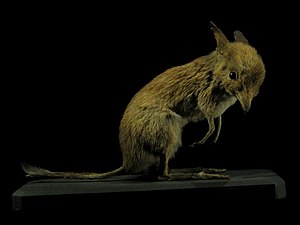Chaeropus yirratji
| Chaeropus yirratji | ||||||||||||
|---|---|---|---|---|---|---|---|---|---|---|---|---|

A paratype of Chaeropus yirratji exhibited in the Muséum national d'histoire naturelle in Paris |
||||||||||||
| Systematics | ||||||||||||
|
||||||||||||
| Scientific name | ||||||||||||
| Chaeropus yirratji | ||||||||||||
| Travouillon , Simões , Miguez , Brace , Brewer , Stemmer, Price , Cramb & Louys , 2019 |
Chaeropus yirratji is an extinct species of mammal from the nasal sac family(Peramelemorphia). It was only described in 2019 after a new examination of specimens, skulls and skins of the pig's foot nasal sacs ( Chaeropus ) and occurred in the deserts of Western Australia , Southern Australia and the Northern Territory . Pleistocene fossils of the specieshave also been found in northeast Queensland at Chillagoe and the Broken River . Chaeropus yirratji became extinct after the colonization of Australia by Europeans and, according to Aboriginal reports, could havelived until the 1950s.
features
Chaeropus yirratji had a head body length of 23 to 26 cm, a hind foot length of 72 to 79 mm, ears 49 to 77 mm in height and a 12.3 to 14.8 cm long tail. The weight of the animals is estimated at 300 to 600 grams. The holotype , an adult male preserved in alcohol, has a chestnut brown fur on the back and is light gray-brown on the sides, on the abdomen and on the legs. Different paratypes have a cream or white belly. Some other preparations and skins show a completely different color. They are golden yellow on the back and cream or white on the belly. The authors of the first description do not believe that the color differences can be explained by fading, as the different colorations occur in both wet and dry preparations and fading in wet or dry preparations is usually completely different from one another. Rather, they assume that there were two color morphs in Chaeropus yirratji , similar to other Australian mammals (e.g. swamp wallaby ( Wallabia bicolor ), lemur ring-pouch ( Hemibelideus lemuroides ), brushland ( Trichosurus vulpecula ) and dark ones Round-leaf nose ( Hipposideros ater )). The morphology of the skull and the strange feet with only two toes with hoof-like claws on the front feet and four toes on the hind feet, only one of which touched the ground while walking, are like that of Chaeropus ecaudatus . The hind feet of Chaeropus yirratji are only slightly longer (> 70 mm). In addition, Chaeropus yirratji differs from Chaeropus ecaudatus by an average longer tail (> 120 mm), the missing openings in the upper jaw and a larger tooth hump on the molars. The tail of Chaeropus yirratji has on the top a dark hair comb and a shorter, lighter hair comb on the bottom.
Way of life
Chaeropus yirratji was found in the sandy, grass-covered deserts of the arid interior of Australia. The species was probably crepuscular or nocturnal, spent the day in grass nests and fed mainly on grass and leaves, as well as insects, including ants and termites, and carrion.
supporting documents
- ↑ a b c Kenny J. Travouillon, Bruno F. Simões, Roberto Portela Miguez, Selina Brace, Phillipa Brewer, David Stemmer, Gilbert J. Price, Jonathan Cramb and Julien Louys. 2019. Hidden in Plain Sight: Reassessment of the Pig-footed Bandicoot, Chaeropus ecaudatus (Peramelemorphia, Chaeropodidae), with A Description of A New Species from central Australia, and Use of the Fossil Record to Trace Its Past Distribution. Zootaxa. 4566 (1); 1-69. DOI: 10.11646 / zootaxa.4566.1.1